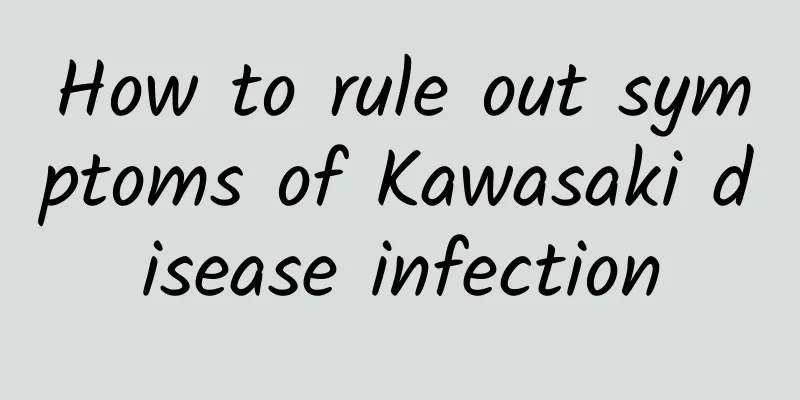How to rule out symptoms of Kawasaki disease infection

|
Symptoms of Kawasaki disease include persistent high fever, rash, changes in oral mucosa, redness and swelling of hands and feet, etc., which need to be ruled out through clinical examination and laboratory tests. Timely medical treatment is the key, and doctors will confirm the diagnosis through blood routine, electrocardiogram, echocardiogram and other tests. 1. The main symptoms of Kawasaki disease Kawasaki disease is an acute febrile illness with systemic vasculitis as the main lesion, which is common in children under 5 years old. Typical symptoms include persistent high fever for more than 5 days, accompanied by rash, oral mucosal congestion, redness and swelling of hands and feet, swollen lymph nodes in the neck, etc. Some children may develop heart complications such as coronary artery dilatation or myocarditis. 2. How to rule out Kawasaki disease Clinical examination is the first step in diagnosing Kawasaki disease. Doctors will make a preliminary judgment on whether it is Kawasaki disease by observing the child's symptoms, such as the duration of fever, distribution of rash, changes in oral mucosa, etc. Laboratory tests include blood routine, C-reactive protein, erythrocyte sedimentation rate, etc., which are used to assess the degree of inflammation. Echocardiography can observe whether the coronary arteries are affected, which is an important basis for diagnosis. 3. Treatment methods The treatment of Kawasaki disease focuses on controlling inflammation and preventing complications. Intravenous immunoglobulin is the preferred treatment option, usually used in the early stages of the disease, and can significantly reduce the risk of coronary artery disease. Aspirin is a commonly used adjuvant drug for anti-inflammatory and anti-platelet aggregation. For severe cases, glucocorticoids or other immunosuppressants may be needed. 4. Home care advice During treatment, parents need to closely monitor the child's symptoms, such as body temperature, rash, mental state, etc. Keep the child well rested and hydrated, and avoid strenuous activities. The diet should be light and easy to digest, and spicy and irritating foods should be avoided. Regular follow-up visits should be conducted to monitor heart function, and possible complications should be discovered and treated in a timely manner. Early diagnosis and timely treatment of Kawasaki disease are crucial. Parents should be vigilant and seek medical attention as soon as possible if they find suspected symptoms. Through standardized medical intervention and home care, most children can fully recover and avoid serious complications. |
<<: Which department should I go to for diagnosis of ADHD in children?
>>: Drug treatment of patent ductus arteriosus in newborns
Recommend
Symptoms of hand, foot and mouth disease in children
Symptoms of hand, foot and mouth disease in child...
When is the best time for children to take calcium supplements? It is recommended to take calcium supplements before going to bed or after breakfast.
The best time for children to take calcium is bef...
How to treat zinc deficiency in children?
When a child is zinc deficient, he must first und...
16.6 Is neonatal jaundice serious?
16.6 Is neonatal jaundice serious? Neonatal jaund...
How to reduce the fever caused by hand, foot and mouth disease? What are the symptoms of hand, foot and mouth disease fever?
Hand, foot and mouth disease is a relatively comm...
What to do when children have a cold and cough? Diet therapy can help
Children's colds are extremely common minor a...
What causes childhood convulsions? How to treat childhood convulsions?
The occurrence of adverse symptoms such as convul...
Expert: Hand, foot and mouth disease is mainly prevented. Introduction to methods to prevent hand, foot and mouth disease
Every May, Beijing enters the peak season for han...
What medicine is good for children with pneumonia and bronchitis?
Pneumonia and bronchitis in children require a do...
What should I do if my 80-day-old baby coughs? Does my 80-day-old baby cough mean he has pneumonia?
Dear parents, please remember that babies are sti...
Is there any relationship between neonatal jaundice and breastfeeding?
Clinically, some breast-fed newborns can be seen ...
What are the common causes of pathological jaundice?
What is pathological jaundice? What are the commo...
Will mycoplasma pneumonia infection recur in children? What medicine should I take?
Mycoplasma pneumoniae infection in children may i...
Can baby hernia be cured?
When a baby has a hernia, it is very painful. If ...
Can people with hand, foot and mouth disease use air conditioning?
Air conditioning is allowed during the period of ...









